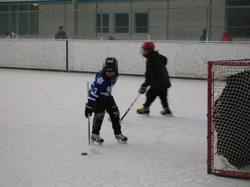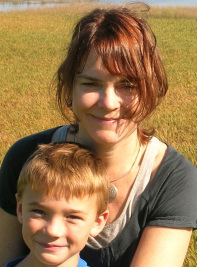
Did you see this study? If you missed it, here’s the gist. Researchers in Toronto recently visited 16 schools and fitted 856 kids in Grades 5 and 6 with gizmos called accelerometers. Then they tracked and recorded kids’ actual activity, not—ahem—self-reported activity. In a city like Toronto, researchers expected “children to perform better than the national average, given that there are more opportunities and resources here,” reported the Toronto Star. What they found was crushing:
- 99% of GTA children don’t get enough exercise (that is, 60 minutes of “moderate to vigorous” activity per day)
- girls fared significantly worse than boys—getting 24 minutes of a day to boys’ average 35 minutes.
I’m the mom of one highly athletic and active Grade 3 boy (he fights to wear shorts in November and seems to vibrate even when sitting still). So I figured we have to be in that other 1%, right? ‘How could my son not be getting 60 minutes of activity per day?’
So I created a chart (you can see it below) and set out to track as accurately as I could how much activity my son is getting. In the absence of an accelerometer, my results are far more subjective, but I tried to be as honest as I could.
What I found was somewhat hopeful—Zach seems to meet the minimum daily activity requirements, if not a bit more. Even better, and this applies more broadly, his regular TDSB school day offers great opportunities to get active: through recess and lunch, and through scheduled gym class and pool time. Throw in some extra-curriculars and free play time, and on paper at least, getting 60 minutes seems totally doable.
But as the recent study showed, it’s not happening. And even parents like me, with highly active kids, have reason to worry. In fact, when I drill down into my chart, I see vulnerabilities at every step. Consider the following:
- Inactivity creep - My son is in Grade 3. Study participants were in Grades 5 and 6. Activity levels decrease over time. Scary.
- Lunch and recess – At our school, free time here adds almost 200 minutes per week. But the onus is largely on our kids to make the most of this time (and since parents aren’t there, it’s hard for us to gauge how this time is actually working). Plus, the older kids get the less cool it becomes to for example, chase your friends around playing tag. My son and his friends’ current favourite ways to enjoy free time include soccer, baseball, and various forms of tag. However, like my son says, some kids are starting to spend recess “just talking”. To him that’s still akin to torture, but I can see how that could change by the time he's the age of study participants.
- Uneven access to extra-curriculars – My son gets another good portion of his activity thanks to the fact that we have the ability to pay. But many extra-curriculars (like hockey) are expensive, putting kids from lower-income homes at a disadvantage. This year it's gotten even trickier due to the local teachers' union (EFTO) work action. Free after-school sports extra-curriculars were suspended this year (although that may be changing as I write). Big-picture, this means kids' organized sports involvement can be affected by economics and politics.
- Pool time threatened – Students at our school have a pool and swimming is part of the student curriculum. Not all TDSB students have this perk and even at our school, we’re always fighting to keep the pool open. The same goes for other community recreation centres. That’s another vulnerability.
- Ad hoc – These are the kinds of activities that give my son the most joy—impromptu street hockey games, Nerf-gun battles, after school tobogganing, tag, and baseball, not to mention the ping pong and soccer games he plays with us or his buddies in our rec room. The older he gets though, the more I see this changing. Weekends are scheduled up, friends are captivated by TV, their DS’s and Wii’s, and homework projects encroach on free time.
- Gender stereotypes - Many of the sports my son is involved in see less co-ed participation each year. Today, when it comes to sports, we still seem to cheer on our boys more—with the frightening result that girls are getting way less exercise.
Bottom line: Our kids do have some opportunities for activity each day but, like a great pile of Jenga blocks, the whole thing is just waiting to be knocked down. Getting our kids 60 minutes of solid activity per day is doable, but without a concerted family, school and community action plan, chances are it’s not going to happen.
My Chart:
SCHOOL ACTIVITY
School swim class: 1 x 30 minutes/wk or 30 minutes weekly
Gym class: 2 x 30 minutes/wk or 60 minutes weekly
Recess: 5 x 24 minutes/wk or 120 minutes weekly
Lunch: 5 x 15 minutes/wk or 75 minutes weekly
TOTAL 285 minutes weekly = 40.7 minutes per day
Extra-curriculars
Swimming lessons: 1 x 40 minutes or 40 minutes weekly
Hockey games: 1 x 20 minutes (40 min. total, real play=20 min.) or 20 minutes weekly
Hockey practice: Alternate weeks 1 x 60 minutes or 30 minutes weekly
Ball Hockey league: 1 x 60 minutes/wk (60 min. total=real play=50 min.) or 50 minutes weekly
TOTAL 140 minutes weekly = 20.0 minutes per day
Ad-hoc
Walk to school: 2 x 3 minutes/day or 30 minutes weekly
Playing outside or indoor sports (street hockey, running around, skating, soccer, ping pong):
20 minutes/day or 140 minutes weekly
TOTAL: 170 minutes weekly = 24.3 minutes per day
WEEKLY TOTAL = 85 minutes per week
More:
- 99% of GTA children not getting enough exercise: study." The Toronto Star, March 4, 2013
- The actual study if you want to have a look: How active are children in Toronto? A comparison with accelerometry data from the Canadian Health Measures Survey



 RSS Feed
RSS Feed
